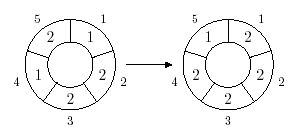 Рабочее место участника
Рабочее место участника
| Выбрать соревнование | Задачи | Послать решение | Результаты проверки | Статистика по задачам | Вопросы и ответы | Результаты соревнования | Состояние сервера | Изменить данные | Управление командой | Помощь |
 Задачи
Задачи
123. Cellular Automaton Производящие функции и матричное представление
Производящие функции и матричное представлениеМатрицы
Олимпиадные задачи на английском языке

| 12/12/2006 | Практическое занятие 13 (задачи NEERC 2006) (C) |
Ограничения: время – 3s/6s, память – 64MiB Ввод: input.txt или стандартный ввод Вывод: output.txt или стандартный вывод 
Послать решение Blockly Посылки Темы Где Обсудить (0)
A cellular automaton is a collection of cells on a grid of specified shape that evolves through a number
of discrete time steps according to a set of rules that describe the new state of a cell based on the states
of neighboring cells. The order of the cellular automaton is the number of cells it contains. Cells of the
automaton of order n are numbered from 1 to `n`.
The order of the cell is the number of different values it may contain. Usually, values of a cell of order
m are considered to be integer numbers from 0 to `m` – 1.
One of the most fundamental properties of a cellular automaton is the type of grid on which it is computed.
In this problem we examine the special kind of cellular automaton — circular cellular automaton of order
`n` with cells of order `m`. We will denote such kind of cellular automaton as `n,m`-automaton.
A distance between cells `i` and `j` in `n,m`-automaton is defined as `min(|i-j|;\ n-|i-j|)`. A `d`-environment
of a cell is the set of cells at a distance not greater than `d`.
On each `d`-step values of all cells are simultaneously replaced by new values. The new value of cell `i` after
`d`-step is computed as a sum of values of cells belonging to the `d`-enviroment of the cell `i` modulo `m`.
The following picture shows 1-step of the 5,3-automaton.

The problem is to calculate the state of the `n,m`-automaton after `k\ d`-steps.
Input
The first line of the input file contains four integer numbers `n,\ m,\ d,` and `k\ (1\ ≤\ n\ ≤\ 500,\ 1\ ≤\ m\ ≤\ 1\ 000\ 000,\ 0\ ≤\ d\ <\ n/2\ ,\ 1\ ≤\ k\ ≤\ 10\ 000\ 000)`. The second line contains `n` integer numbers
from 0 to `m` – 1 — initial values of the automaton’s cells.
Output
Output the values of the `n,m`-automaton’s cells after `k\ d`-steps.
Sample Input #1
5 3 1 1 1 2 2 1 2
Sample Output #1
2 2 2 2 1
Sample Input #2
5 3 1 10 1 2 2 1 2
Sample Output #2
2 0 0 2 2
 Начало
Начало